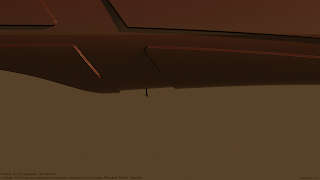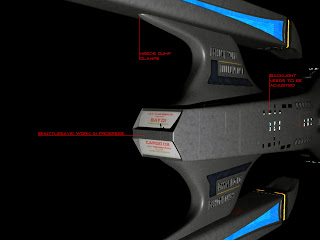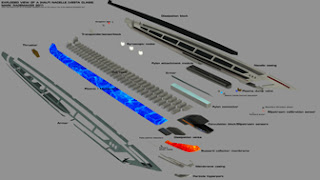Dwight Williams commented on my Vienna class starship. I was about to write back within the Picasa album, but then I noticed I only had 512 characters. :)
Anyway we are talking about this starship:
Back in the day (2003) this was fine for me. It was my second serious 3ds Max model created with all kind of new techniques that Truespace (my previous modeling software) did not have. It also was my first Star Trek inspired ship. I loved working on this as well as keeping the guys at SCN (my favorite board) updated with build up shots. I learned a ton, but in retrospect: it's rather flawed. (modeling and design wise.)
Lets see:
Design: not present, I was only working on a mesh and battling smoothing errors. My design eye was untrained. (It's half trained now, hence no Enterprise F :P)
Modeling issues: It suffers from blobbyness, where the mesh itself has too little information for the meshsmooth modifier to work with. These surfaces become rather curvy and undefined. It's a huge NO. I sometimes see people still doing this, it's the nr 1 method to make an "alien" ship. (sadly lol)
The escape pods: they are stuck into the main hull, as are most items on this ship. I had no clue how to conform parts into or onto the hull. I just created something that I could move (manually) down the hull mesh. Same goes for the phaser strips. No clue how to make a conforming phaser bank, so these strips would mask that lack of talent/skill.
Windows: I tried thousands of methods (ok I tried 3), but ended up with texturing them in. I created a huge alpha map and used it as bump + opacity map. Some lit inner textures do the rest. That actually worked out rather well, but it felt too much like cheating, even if it would be closer to the real thing in 300 years then an actual window. I think hullparts can become transparent on demand by then.
Details:
The poly modeling parts where very detailed. It's the easy part. But imagine taking a close up of that deflector when it's on the model, you have this rather detailed deflector, but the surrounding hull still is flat and uninteresting and shows clearly that the deflector is just stuck into it. The difference is too large. Fun: yes, but another NO in retrospect.
Bridge module:
This was done with patch modeling, splinecage and all. I had zip experience with that, and I dont really know why I did it with patch modeling, but the result was pretty ok. Probably the best part of this model. (By coincidence)
Inner bridge: Sized like a ballroom, but in some shots had a glimpse of realism that the outside lacked.
Conclusion: I made big learning steps with this one, but it's a museum piece, not something I would like to render again. :)














